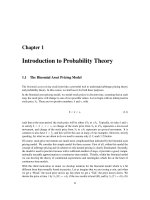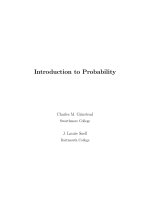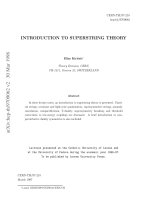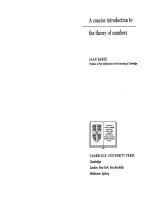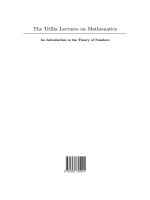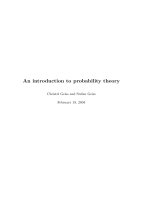Introduction to Probability Theory
Bạn đang xem bản rút gọn của tài liệu. Xem và tải ngay bản đầy đủ của tài liệu tại đây (269.55 KB, 38 trang )
Chapter 1
Introduction to Probability Theory
1.1 The Binomial Asset Pricing Model
The binomial asset pricing model provides a powerful tool to understand arbitrage pricing theory
and probability theory. In this course, we shall use it for both these purposes.
In the binomial asset pricing model, we model stock prices in discrete time, assuming that at each
step, the stock price will change to one of two possible values. Let us begin with an initial positive
stock price
S
0
. There are two positive numbers,
d
and
u
, with
0 du;
(1.1)
such that at the next period, the stock price will be either
dS
0
or
uS
0
. Typically, we take
d
and
u
to satisfy
0 d1u
, so change of the stock price from
S
0
to
dS
0
represents a downward
movement, and change of the stock price from
S
0
to
uS
0
represents an upward movement. It is
commontoalsohave
d =
1
u
, and this will be the case in many of our examples. However, strictly
speaking, for what we are about to do we need to assume only (1.1) and (1.2) below.
Of course, stock price movements are much more complicated than indicated by the binomial asset
pricing model. We consider this simple model for three reasons. First of all, within this model the
concept of arbitrage pricing and its relation to risk-neutral pricing is clearly illuminated. Secondly,
the model is used in practice because with a sufficient number of steps, it provides a good, compu-
tationally tractable approximation to continuous-time models. Thirdly, within the binomial model
we can develop the theory of conditional expectations and martingales which lies at the heart of
continuous-time models.
With this third motivation in mind, we develop notation for the binomial model which is a bit
different from that normally found in practice. Let us imagine that we are tossing a coin, and when
we get a “Head,” the stock price moves up, but when we get a “Tail,” the price moves down. We
denote the price at time
1
by
S
1
H = uS
0
if the toss results in head (H), and by
S
1
T = dS
0
if it
11
12
S = 4
0
S (H) = 8
S (T) = 2
S (HH) = 16
S (TT) = 1
S (HT) = 4
S (TH) = 4
1
1
2
2
2
2
Figure 1.1: Binomial tree of stock prices with
S
0
=4
,
u=1=d =2
.
results in tail (T). After the second toss, the price will be one of:
S
2
HH= uS
1
H =u
2
S
0
; S
2
HT = dS
1
H =duS
0
;
S
2
TH= uS
1
T =udS
0
; S
2
TT=dS
1
T =d
2
S
0
:
After three tosses,thereare eight possible coinsequences, althoughnotall of them resultin different
stock prices at time
3
.
For the moment, let us assume that the third toss is the last one and denote by
=fHHH; HHT; HTH; HTT; THH; T HT; T T H; T T Tg
the set of all possible outcomes of the three tosses. The set
of all possible outcomes of a ran-
dom experiment is called the sample space for the experiment, and the elements
!
of
are called
sample points. In this case, each sample point
!
is a sequence of length three. We denote the
k
-th
component of
!
by
!
k
. For example, when
! = HT H
,wehave
!
1
= H
,
!
2
= T
and
!
3
= H
.
The stock price
S
k
at time
k
depends on the coin tosses. To emphasize this, we often write
S
k
!
.
Actually, this notation does not quite tell the whole story, for while
S
3
depends on all of
!
,
S
2
depends on only the first two components of
!
,
S
1
depends on only the first component of
!
,and
S
0
does not depend on
!
at all. Sometimes we will use notation such
S
2
!
1
;!
2
just to record more
explicitly how
S
2
depends on
! =!
1
;!
2
;!
3
.
Example 1.1 Set
S
0
=4
,
u=2
and
d =
1
2
. We have then the binomial “tree” of possible stock
prices shown in Fig. 1.1. Each sample point
! =!
1
;!
2
;!
3
represents a path through the tree.
Thus, we can think of the sample space
as either the set of all possible outcomes from three coin
tosses or as the set of all possible paths through the tree.
To complete our binomial asset pricing model, we introduce a money market with interest rate
r
;
$1 invested in the money market becomes
$1 + r
in the next period. We take
r
to be the interest
CHAPTER 1. Introduction to Probability Theory
13
rate for both borrowing and lending. (This is not as ridiculous as it first seems, because in a many
applications of the model, an agent is either borrowing or lending (not both) and knows in advance
which she will be doing; in such an application, she should take
r
to be the rate of interest for her
activity.) We assume that
d1+ ru:
(1.2)
The model would not make sense if we did not have this condition. For example, if
1+r u
,then
the rate of return on the money market is always at least as great as and sometimes greater than the
return on the stock, and no one would invest in the stock. The inequality
d 1+r
cannot happen
unless either
r
is negative (which never happens, except maybe once upon a time in Switzerland) or
d 1
. In the latter case, the stock does not really go “down” if we get a tail; it just goes up less
than if we had gotten a head. One should borrow money at interest rate
r
and invest in the stock,
since even in the worst case, the stock price rises at least as fast as the debt used to buy it.
With the stock as the underlying asset, let us consider a European call option with strike price
K0
and expiration time
1
. This option confers the right to buy the stock at time
1
for
K
dollars,
andsoisworth
S
1
, K
at time
1
if
S
1
, K
is positive and is otherwise worth zero. We denote by
V
1
! =S
1
!,K
+
= maxfS
1
! , K; 0g
the value (payoff) of this option at expiration. Of course,
V
1
!
actually depends only on
!
1
,and
we can and do sometimes write
V
1
!
1
rather than
V
1
!
. Our first task is to compute the arbitrage
price of this option at time zero.
Suppose at time zero you sell the call for
V
0
dollars, where
V
0
is still to be determined. You now
have an obligation to pay off
uS
0
, K
+
if
!
1
= H
andtopayoff
dS
0
, K
+
if
!
1
= T
.At
the time you sell the option, you don’t yet know which value
!
1
will take. You hedge your short
position in the option by buying
0
shares of stock, where
0
is still to be determined. You can use
the proceeds
V
0
of the sale of the option for this purpose, and then borrow if necessary at interest
rate
r
to complete the purchase. If
V
0
is more than necessary to buy the
0
shares of stock, you
invest the residual money at interest rate
r
. In either case, you will have
V
0
,
0
S
0
dollars invested
in the money market, where this quantity might be negative. You will also own
0
shares of stock.
If the stock goes up, the value of your portfolio (excluding the short position in the option) is
0
S
1
H + 1 + rV
0
,
0
S
0
;
and you need to have
V
1
H
. Thus, you want to choose
V
0
and
0
so that
V
1
H =
0
S
1
H + 1 + rV
0
,
0
S
0
:
(1.3)
If the stock goes down, the value of your portfolio is
0
S
1
T + 1 + rV
0
,
0
S
0
;
and you need to have
V
1
T
. Thus, you want to choose
V
0
and
0
to also have
V
1
T =
0
S
1
T + 1 + rV
0
,
0
S
0
:
(1.4)
14
These are two equations in two unknowns, and we solve them below
Subtracting (1.4) from (1.3), we obtain
V
1
H , V
1
T =
0
S
1
H,S
1
T;
(1.5)
so that
0
=
V
1
H , V
1
T
S
1
H , S
1
T
:
(1.6)
This is a discrete-time version of the famous “delta-hedging” formula for derivative securities, ac-
cording to which the number of shares of an underlying asset a hedge should hold is the derivative
(in the sense of calculus) of the value of the derivative security with respect to the price of the
underlying asset. This formula is so pervasive the when a practitioner says “delta”, she means the
derivative (in the sense of calculus) just described. Note, however, that my definition of
0
is the
number of shares of stock one holds at time zero, and (1.6) is a consequence of this definition, not
the definition of
0
itself. Depending on how uncertainty enters the model, there can be cases
in which the number of shares of stock a hedge should hold is not the (calculus) derivative of the
derivative security with respect to the price of the underlying asset.
To complete the solution of (1.3) and (1.4), we substitute (1.6) into either (1.3) or (1.4) and solve
for
V
0
. After some simplification, this leads to the formula
V
0
=
1
1+r
1+r ,d
u,d
V
1
H+
u, 1 + r
u , d
V
1
T
:
(1.7)
This is the arbitrage price for the European call option with payoff
V
1
at time
1
. To simplify this
formula, we define
~p
=
1+r ,d
u,d
; ~q
=
u,1 + r
u , d
=1,~p;
(1.8)
so that (1.7) becomes
V
0
=
1
1+ r
~pV
1
H+ ~qV
1
T :
(1.9)
Because we have taken
du
, both
~p
and
~q
are defined,i.e., the denominator in (1.8) is not zero.
Because of (1.2), both
~p
and
~q
are in the interval
0; 1
, and because they sum to
1
, we can regard
them as probabilities of
H
and
T
, respectively. They are the risk-neutral probabilites. They ap-
peared when we solved the two equations (1.3) and (1.4), and have nothing to do with the actual
probabilities of getting
H
or
T
on the coin tosses. In fact, at this point, they are nothing more than
a convenient tool for writing (1.7) as (1.9).
We now consider a European call which pays off
K
dollars at time
2
. At expiration, the payoff of
this option is
V
2
=S
2
,K
+
,where
V
2
and
S
2
depend on
!
1
and
!
2
, the first and second coin
tosses. We want to determine the arbitrage price for this option at time zero. Suppose an agent sells
the option at time zero for
V
0
dollars, where
V
0
is still to be determined. She then buys
0
shares
CHAPTER 1. Introduction to Probability Theory
15
of stock, investing
V
0
,
0
S
0
dollars in the money market to finance this. At time
1
, the agent has
a portfolio (excluding the short position in the option) valued at
X
1
=
0
S
1
+1+rV
0
,
0
S
0
:
(1.10)
Although we do not indicate it in the notation,
S
1
and therefore
X
1
depend on
!
1
, the outcome of
the first coin toss. Thus, there are really two equations implicit in (1.10):
X
1
H
=
0
S
1
H + 1 + rV
0
,
0
S
0
;
X
1
T
=
0
S
1
T + 1 + rV
0
,
0
S
0
:
After the first coin toss, the agent has
X
1
dollars and can readjust her hedge. Supposeshe decides to
now hold
1
shares of stock, where
1
is allowed to depend on
!
1
because the agent knows what
value
!
1
has taken. She invests the remainder of her wealth,
X
1
,
1
S
1
in the money market. In
the next period, her wealth will be given by the right-hand side of the following equation, and she
wants it to be
V
2
. Therefore, she wants to have
V
2
=
1
S
2
+1+rX
1
,
1
S
1
:
(1.11)
Although we do not indicate it in the notation,
S
2
and
V
2
depend on
!
1
and
!
2
, the outcomes of the
first two coin tosses. Considering all four possible outcomes, we can write (1.11) as four equations:
V
2
HH =
1
HS
2
HH + 1 + rX
1
H ,
1
H S
1
H ;
V
2
HT =
1
HS
2
HT + 1 + rX
1
H ,
1
H S
1
H ;
V
2
TH =
1
TS
2
TH + 1 + rX
1
T ,
1
T S
1
T ;
V
2
TT =
1
TS
2
TT + 1 + rX
1
T ,
1
T S
1
T :
We now have six equations, the two represented by (1.10) and the four represented by (1.11), in the
six unknowns
V
0
,
0
,
1
H
,
1
T
,
X
1
H
,and
X
1
T
.
To solve these equations, and thereby determine the arbitrage price
V
0
at time zero of the option and
the hedging portfolio
0
,
1
H
and
1
T
, we begin with the last two
V
2
TH =
1
TS
2
TH + 1 + rX
1
T ,
1
T S
1
T ;
V
2
TT =
1
TS
2
TT+1+rX
1
T ,
1
T S
1
T :
Subtracting one of these from the other and solving for
1
T
, we obtain the “delta-hedging for-
mula”
1
T =
V
2
TH , V
2
TT
S
2
TH , S
2
TT
;
(1.12)
and substituting this into either equation, we can solve for
X
1
T =
1
1+r
~pV
2
TH+ ~qV
2
TT:
(1.13)
16
Equation (1.13), gives the value the hedging portfolio should have at time
1
if the stock goes down
between times
0
and
1
. We define this quantity to be the arbitrage value of the option at time
1
if
!
1
= T
, and we denote it by
V
1
T
.Wehavejustshownthat
V
1
T
=
1
1+r
~pV
2
TH+ ~qV
2
TT:
(1.14)
The hedger should choose her portfolio so that her wealth
X
1
T
if
!
1
= T
agrees with
V
1
T
defined by (1.14). This formula is analgous to formula (1.9), but postponed by one step. The first
two equations implicit in (1.11) lead in a similar way to the formulas
1
H =
V
2
HH , V
2
HT
S
2
HH , S
2
HT
(1.15)
and
X
1
H =V
1
H
,where
V
1
H
is the value of the option at time
1
if
!
1
= H
,definedby
V
1
H
=
1
1+r
~pV
2
HH+ ~qV
2
HT :
(1.16)
This is again analgousto formula (1.9), postponed by onestep. Finally, we plug the values
X
1
H =
V
1
H
and
X
1
T =V
1
T
into the two equations implicit in (1.10). The solution of these equa-
tions for
0
and
V
0
is the same as the solution of (1.3) and (1.4), and results again in (1.6) and
(1.9).
The pattern emerging here persists, regardless of the number of periods. If
V
k
denotes the value at
time
k
of a derivative security, and this depends on the first
k
coin tosses
!
1
;:::;!
k
, then at time
k , 1
, after the first
k , 1
tosses
!
1
;:::;!
k,1
are known, the portfolio to hedge a short position
should hold
k,1
!
1
;:::;!
k,1
shares of stock, where
k,1
!
1
;:::;!
k,1
=
V
k
!
1
;:::;!
k,1
;H, V
k
!
1
;:::;!
k,1
;T
S
k
!
1
;:::;!
k,1
;H, S
k
!
1
;:::;!
k,1
;T
;
(1.17)
and the value at time
k , 1
of the derivative security, when the first
k , 1
coin tosses result in the
outcomes
!
1
;:::;!
k,1
,isgivenby
V
k,1
!
1
;:::;!
k,1
=
1
1+r
~pV
k
!
1
;:::;!
k,1
;H+ ~qV
k
!
1
;:::;!
k,1
;T
(1.18)
1.2 Finite Probability Spaces
Let
be a set with finitely many elements. An example to keep in mind is
=fHHH; HHT; HTH; HTT; THH; T HT; T T H; T T Tg
(2.1)
of all possible outcomes of three coin tosses. Let
F
be the set of all subsets of
.Somesetsin
F
are
;
,
fHHH; HHT; HTH; HTT g
,
fTTTg
,and
itself. How many sets are there in
F
?
CHAPTER 1. Introduction to Probability Theory
17
Definition 1.1 A probability measure
IP
is a function mapping
F
into
0; 1
with the following
properties:
(i)
IP = 1
,
(ii) If
A
1
;A
2
;:::
is a sequence of disjoint sets in
F
,then
IP
1
k=1
A
k
!
=
1
X
k=1
IP A
k
:
Probability measures have the following interpretation. Let
A
be a subset of
F
. Imagine that
is
the set of all possible outcomes of some random experiment. There is a certain probability, between
0
and
1
, that when that experiment is performed, the outcome will lie in the set
A
. We think of
IP A
as this probability.
Example 1.2 Suppose a coin has probability
1
3
for
H
and
2
3
for
T
. For the individual elements of
in (2.1), define
IP fHHHg =
1
3
3
; IP fHHT g =
1
3
2
2
3
;
IP fHT Hg =
1
3
2
2
3
; IP fHT T g =
1
3
2
3
2
;
IPfTHHg =
1
3
2
1
3
; IPfTHTg =
1
3
2
3
2
;
IPfTTHg =
1
3
2
3
2
; IPfTTTg =
2
3
3
:
For
A 2F
,wedefine
IP A=
X
!2A
IPf!g:
(2.2)
For example,
IP fHHH; HHT; HTH; HTT g =
1
3
3
+2
1
3
2
2
3
+
1
3
2
3
2
=
1
3
;
which is another way of saying that the probability of
H
on the first toss is
1
3
.
As in the above example, it is generally the case that we specify a probability measure on only some
of the subsets of
and then use property (ii) of Definition 1.1 to determine
IP A
for the remaining
sets
A 2F
. In the above example, we specified the probabilitymeasure only for the sets containing
a single element, and then used Definition 1.1(ii) in the form (2.2) (see Problem 1.4(ii)) to determine
IP
for all the other sets in
F
.
Definition 1.2 Let
be a nonempty set. A
-algebra is a collection
G
of subsets of
with the
following three properties:
(i)
;2G
,
18
(ii) If
A 2G
, then its complement
A
c
2G
,
(iii) If
A
1
;A
2
;A
3
;:::
is a sequence of sets in
G
,then
1
k=1
A
k
is also in
G
.
Here are some important
-algebras of subsets of the set
in Example 1.2:
F
0
=
;;
;
F
1
=
;; ; fHH H; HHT; HT H; HT T g; fTHH; THT;TTH;TTTg
;
F
2
=
;; ; fHHH; HHTg; fHT H; HT T g; fTHH; THTg; fTTH;TTTg;
and all sets which can be built by taking unions of these
;
F
3
= F =
The set of all subsets of
:
To simplify notation a bit, let us define
A
H
= fHHH; HHT; HTH; HTT g = fH
on the first toss
g;
A
T
= fTHH; THT;TTH; TTTg = fT
on the first toss
g;
so that
F
1
= f;; ;A
H
;A
T
g;
and let us define
A
HH
= fHHH; HHTg = fHH
on the first two tosses
g;
A
HT
= fHT H; HT T g = fHT
on the first two tosses
g;
A
TH
= fTHH; THTg = fTH
on the first two tosses
g;
A
TT
= fTTH; TTTg = fTT
on the first two tosses
g;
so that
F
2
= f;; ;A
HH
;A
HT
;A
TH
;A
TT
;
A
H
;A
T
;A
HH
A
TH
;A
HH
A
TT
;A
HT
A
TH
;A
HT
A
TT
;
A
c
HH
;A
c
HT
;A
c
TH
;A
c
TT
g:
We interpret
-algebras as a record of information. Suppose the coin is tossed three times, and you
are not told the outcome, but you are told, for every set in
F
1
whether or not the outcome is in that
set. For example, you would be told that the outcome is not in
;
and is in
. Moreover, you might
be told that the outcome is not in
A
H
but is in
A
T
. In effect, you have been told that the first toss
was a
T
, and nothing more. The
-algebra
F
1
is said to contain the “information of the first toss”,
which is usually called the “information up to time
1
”. Similarly,
F
2
contains the “information of
CHAPTER 1. Introduction to Probability Theory
19
the first two tosses,” which is the “information up to time
2
.” The
-algebra
F
3
= F
contains “full
information” about the outcome of all three tosses. The so-called “trivial”
-algebra
F
0
contains no
information. Knowing whether the outcome
!
of the three tosses is in
;
(it is not) and whether it is
in
(it is) tells you nothing about
!
Definition 1.3 Let
be a nonemptyfinite set. A filtrationis a sequence of
-algebras
F
0
; F
1
; F
2
;:::;F
n
such that each
-algebra in the sequence contains all the sets contained by the previous
-algebra.
Definition 1.4 Let
be a nonempty finite set and let
F
be the
-algebra of all subsets of
.A
random variable is a function mapping
into
IR
.
Example 1.3 Let
be given by (2.1) and consider the binomial asset pricing Example 1.1, where
S
0
=4
,
u=2
and
d =
1
2
.Then
S
0
,
S
1
,
S
2
and
S
3
are all random variables. For example,
S
2
HHT = u
2
S
0
=16
. The “random variable”
S
0
is really not random, since
S
0
! = 4
for all
! 2
. Nonetheless, it is a function mapping
into
IR
, and thus technically a random variable,
albeit a degenerate one.
A random variable maps
into
IR
, and we can look at the preimage under the random variable of
sets in
IR
. Consider, for example, the random variable
S
2
of Example 1.1. We have
S
2
HHH= S
2
HHT = 16;
S
2
HT H= S
2
HT T = S
2
THH= S
2
THT= 4;
S
2
TTH=S
2
TTT=1:
Let us consider the interval
4; 27
. The preimage under
S
2
of this interval is defined to be
f! 2 ; S
2
! 2 4; 27g = f! 2 ; 4 S
2
27g = A
c
TT
:
The complete list of subsets of
we can get as preimages of sets in
IR
is:
;; ;A
HH
;A
HT
A
TH
;A
TT
;
and sets which can be built by taking unions of these. This collection of sets is a
-algebra, called
the
-algebra generated by the random variable
S
2
, and is denoted by
S
2
. The information
content of this
-algebra is exactly the information learned by observing
S
2
. More specifically,
suppose the coin is tossed three times and you do not know the outcome
!
, but someone is willing
to tell you, for each set in
S
2
,whether
!
is in the set. You might be told, for example, that
!
is
not in
A
HH
,isin
A
HT
A
TH
, and is not in
A
TT
. Then you know that in the first two tosses, there
was a head and a tail, and you know nothing more. This information is the same you would have
gotten by being told that the value of
S
2
!
is
4
.
Note that
F
2
defined earlier contains all the sets which are in
S
2
, and even more. This means
that the information in the first two tosses is greater than the information in
S
2
. In particular, if you
see the first two tosses, you can distinguish
A
HT
from
A
TH
, but you cannot make this distinction
from knowing the value of
S
2
alone.
20
Definition 1.5 Let
be a nonemtpy finite set and let
F
be the
-algebra of all subsets of
.Let
X
be a random variable on
; F
.The
-algebra
X
generated by
X
is defined to be the collection
of all sets of the form
f! 2 ; X ! 2 Ag
,where
A
is a subset of
IR
.Let
G
be a sub-
-algebra of
F
. We say that
X
is
G
-measurable if every set in
X
is also in
G
.
Note: We normally write simply
fX 2 Ag
rather than
f! 2 ; X ! 2 Ag
.
Definition 1.6 Let
be a nonempty, finite set, let
F
be the
-algebra of all subsets of
,let
IP
be
a probabilty measure on
; F
,andlet
X
be a random variable on
. Given any set
A IR
,we
define the induced measure of
A
to be
L
X
A
= IP fX 2 Ag:
In other words, the induced measure of a set
A
tells us the probability that
X
takes a value in
A
.In
the case of
S
2
above with the probability measure of Example 1.2, some sets in
IR
and their induced
measures are:
L
S
2
;=IP;=0;
L
S
2
IR=IP=1;
L
S
2
0; 1= IP=1;
L
S
2
0; 3 = IP fS
2
=1g=IPA
TT
=
2
3
2
:
In fact, the induced measure of
S
2
places a mass of size
1
3
2
=
1
9
at the number
16
, a mass of size
4
9
at the number
4
,andamassofsize
2
3
2
=
4
9
at the number
1
. A common way to record this
information is to give the cumulative distribution function
F
S
2
x
of
S
2
,definedby
F
S
2
x
= IP S
2
x=
8
:
0;
if
x1;
4
9
;
if
1 x4;
8
9
;
if
4 x16;
1;
if
16 x:
(2.3)
By the distribution of a random variable
X
, we mean any of the several ways of characterizing
L
X
.If
X
is discrete, as in the case of
S
2
above, we can either tell where the masses are and how
large they are, or tell what the cumulative distribution function is. (Later we will consider random
variables
X
which have densities, in which case the induced measure of a set
A IR
is the integral
of the density over the set
A
.)
Important Note. In order to work through the concept of a risk-neutral measure, we set up the
definitions to make a clear distinction between random variables and their distributions.
A random variable is a mapping from
to
IR
, nothing more. It has an existence quite apart from
discussion of probabilities. For example, in the discussion above,
S
2
TTH= S
2
TTT= 1
,
regardless of whether the probability for
H
is
1
3
or
1
2
.
CHAPTER 1. Introduction to Probability Theory
21
The distribution of a random variable is a measure
L
X
on
IR
, i.e., a way of assigning probabilities
to sets in
IR
. It depends on the random variable
X
and the probabilitymeasure
IP
we use in
.Ifwe
set the probability of
H
to be
1
3
,then
L
S
2
assigns mass
1
9
to the number
16
. If we set the probability
of
H
to be
1
2
,then
L
S
2
assigns mass
1
4
to the number
16
. The distribution of
S
2
has changed, but
the random variable has not. It is still defined by
S
2
HHH= S
2
HHT = 16;
S
2
HT H= S
2
HT T = S
2
THH= S
2
THT= 4;
S
2
TTH=S
2
TTT=1:
Thus, a random variable can have more than one distribution(a “market” or “objective” distribution,
and a “risk-neutral” distribution).
In a similar vein, two different random variables can have the same distribution. Suppose in the
binomial model of Example 1.1, the probability of
H
and the probability of
T
is
1
2
. Consider a
European call with strike price
14
expiring at time
2
. The payoff of the call at time
2
is the random
variable
S
2
, 14
+
, which takes the value
2
if
! = HHH
or
! = HHT
, and takes the value
0
in
every other case. Theprobabilitythe payoff is
2
is
1
4
, and the probabilityitiszero is
3
4
. Consider also
a European put with strike price
3
expiring at time
2
. The payoff of the put at time
2
is
3 , S
2
+
,
which takes the value
2
if
! = TTH
or
! = TTT
. Like the payoff of the call, the payoff of the
put is
2
with probability
1
4
and
0
with probability
3
4
. The payoffs of the call and the put are different
random variables having the same distribution.
Definition 1.7 Let
be a nonempty, finite set, let
F
be the
-algebra of all subsets of
,let
IP
be
a probabilty measure on
; F
,andlet
X
be a random variable on
.Theexpected value of
X
is
defined to be
IEX
=
X
!2
X!IP f!g:
(2.4)
Notice that the expected value in (2.4) is defined to be a sum over the sample space
.Since
is a
finite set,
X
can take only finitely many values, which we label
x
1
;:::;x
n
. We can partition
into
the subsets
fX
1
= x
1
g;:::;fX
n
= x
n
g
, and then rewrite (2.4) as
IEX
=
X
!2
X!IP f!g
=
n
X
k=1
X
!2fX
k
=x
k
g
X ! IP f! g
=
n
X
k=1
x
k
X
!2fX
k
=x
k
g
IP f! g
=
n
X
k=1
x
k
IP fX
k
= x
k
g
=
n
X
k=1
x
k
L
X
fx
k
g:
22
Thus, although the expected value is defined as a sum over the sample space
, we can also write it
as a sum over
IR
.
To make the above set of equations absolutely clear, we consider
S
2
with the distribution given by
(2.3). The definition of
IES
2
is
IES
2
= S
2
HHHIP fHHHg + S
2
HHT IP fHHT g
+S
2
HT HIP fHT Hg + S
2
HT T IP fHT T g
+S
2
THHIPfTHHg+ S
2
THTIPfTHTg
+S
2
TTHIPfTTHg + S
2
TTTIPfTTTg
= 16 IP A
HH
+4IPA
HT
A
TH
+ 1IPA
TT
= 16 IP fS
2
=16g+4IPfS
2
=4g+1IPfS
2
=1g
= 16 L
S
2
f16g +4L
S
2
f4g+1L
S
2
f1g
= 16
1
9
+4
4
9
+4
4
9
=
48
9
:
Definition 1.8 Let
be a nonempty, finite set, let
F
be the
-algebra of all subsets of
,let
IP
be a
probabilty measure on
; F
,andlet
X
be a random variable on
.Thevariance of
X
is defined
to be the expected value of
X , IEX
2
, i.e.,
Var
X
=
X
! 2
X ! , IEX
2
IP f!g:
(2.5)
One again, we can rewrite (2.5) as a sum over
IR
rather than over
. Indeed, if
X
takes the values
x
1
;:::;x
n
,then
Var
X =
n
X
k=1
x
k
, IEX
2
IP fX = x
k
g =
n
X
k=1
x
k
, IEX
2
L
X
x
k
:
1.3 Lebesgue Measure and the Lebesgue Integral
In this section, we consider the set of real numbers
IR
, which is uncountably infinite. We define the
Lebesgue measure of intervals in
IR
to be their length. This definition and the properties of measure
determine the Lebesgue measure of many, but not all, subsets of
IR
. The collection of subsets of
IR
we consider, and for which Lebesgue measure is defined, is the collection of Borel sets defined
below.
We use Lebesgue measure to construct the Lebesgue integral, a generalization of the Riemann
integral. We need this integral because, unlike the Riemann integral, it can be defined on abstract
spaces, such as the space of infinite sequences of coin tosses or the space of paths of Brownian
motion. This section concerns the Lebesgue integral on the space
IR
only; the generalization to
other spaces will be given later.
CHAPTER 1. Introduction to Probability Theory
23
Definition 1.9 The Borel
-algebra, denoted
BIR
, is the smallest
-algebra containing all open
intervals in
IR
. The sets in
BIR
are called Borel sets.
Every set which can be written down and just about every set imaginable is in
BIR
. The following
discussion of this fact uses the
-algebra properties developed in Problem 1.3.
By definition, every open interval
a; b
is in
BIR
,where
a
and
b
are real numbers. Since
BIR
is
a
-algebra, every union of open intervals is also in
BIR
. For example, for every real number
a
,
the open half-line
a; 1=
1
n=1
a; a + n
is a Borel set, as is
,1;a=
1
n=1
a , n; a:
For real numbers
a
and
b
, the union
,1;a b; 1
is Borel. Since
BIR
is a
-algebra, every complement of a Borel set is Borel, so
BIR
contains
a; b=
,1;a b; 1
c
:
This shows that every closed interval is Borel. In addition, the closed half-lines
a; 1=
1
n=1
a; a + n
and
,1;a=
1
n=1
a , n; a
are Borel. Half-open and half-closed intervals are also Borel, since they can be written as intersec-
tions of open half-lines and closed half-lines. For example,
a; b= ,1;b a; 1:
Every set which contains only one real number is Borel. Indeed, if
a
is a real number, then
fag =
1
n=1
a ,
1
n
;a+
1
n
:
This means that every set containing finitely many real numbers is Borel; if
A = fa
1
;a
2
;:::;a
n
g
,
then
A =
n
k=1
fa
k
g:
24
In fact, every set containing countably infinitely many numbers is Borel; if
A = fa
1
;a
2
;:::g
,then
A =
n
k=1
fa
k
g:
This means that the set of rational numbers is Borel, as is its complement, the set of irrational
numbers.
There are, however, sets which are not Borel. We have just seen that any non-Borel set must have
uncountably many points.
Example 1.4 (The Cantor set.) This example gives a hint of how complicated a Borel set can be.
We use it later when we discuss the sample space for an infinite sequence of coin tosses.
Consider the unit interval
0; 1
, and remove the middle half, i.e., remove the open interval
A
1
=
1
4
;
3
4
:
The remaining set
C
1
=
0;
1
4
3
4
; 1
has two pieces. From each of these pieces, remove the middle half, i.e., remove the open set
A
2
=
1
16
;
3
16
13
16
;
15
16
:
The remaining set
C
2
=
0;
1
16
3
16
;
1
4
3
4
;
13
16
15
16
; 1
:
has four pieces. Continue this process, so at stage
k
,theset
C
k
has
2
k
pieces, and each piece has
length
1
4
k
.TheCantor set
C
=
1
k=1
C
k
is defined to be the set of points not removed at any stage of this nonterminating process.
Note that the length of
A
1
, the first set removed, is
1
2
. The “length” of
A
2
, the second set removed,
is
1
8
+
1
8
=
1
4
. The “length” of the next set removed is
4
1
32
=
1
8
, and in general, the length of the
k
-th set removed is
2
,k
. Thus, the total length removed is
1
X
k=1
1
2
k
=1;
and so the Cantor set, the set of points not removed, has zero “length.”
Despite the fact that the Cantor set has no “length,” there are lots of points in this set. In particular,
none of the endpoints of the pieces of the sets
C
1
;C
2
;:::
is ever removed. Thus, the points
0;
1
4
;
3
4
; 1;
1
16
;
3
16
;
13
16
;
15
16
;
1
64
;:::
are all in
C
. This is a countably infinite set of points. We shall see eventually that the Cantor set
has uncountably many points.
CHAPTER 1. Introduction to Probability Theory
25
Definition 1.10 Let
BIR
be the
-algebra of Borel subsets of
IR
.Ameasure on
IR; BIR
is a
function
mapping
B
into
0; 1
with the following properties:
(i)
;=0
,
(ii) If
A
1
;A
2
;:::
is a sequence of disjoint sets in
BIR
,then
1
k=1
A
k
!
=
1
X
k=1
A
k
:
Lebesgue measure is defined to be the measure on
IR; BIR
which assigns the measure of each
interval to be its length. Following Williams’s book, we denote Lebesgue measure by
0
.
A measure has all the properties of a probability measure given in Problem 1.4, except that the total
measure of the space is not necessarily
1
(in fact,
0
IR=1
), one no longer has the equation
A
c
=1,A
in Problem 1.4(iii), and property (v) in Problem 1.4 needs to be modified to say:
(v) If
A
1
;A
2
;:::
is a sequence of sets in
BIR
with
A
1
A
2
and
A
1
1
,then
1
k=1
A
k
!
= lim
n!1
A
n
:
To see that the additional requirment
A
1
1
is needed in (v), consider
A
1
=1;1;A
2
=2;1;A
3
=3;1;::::
Then
1
k=1
A
k
= ;
,so
0
1
k=1
A
k
=0
,but
lim
n!1
0
A
n
=1
.
We specify that the Lebesgue measure of each intervalis its length, and thatdetermines the Lebesgue
measure of all other Borel sets. For example, the Lebesgue measure of the Cantor set in Example
1.4 must be zero, because of the “length” computation given at the end of that example.
The Lebesgue measure of a set containing only one point must be zero. In fact, since
fag
a,
1
n
;a+
1
n
for every positive integer
n
,wemusthave
0
0
fag
0
a,
1
n
;a +
1
n
=
2
n
:
Letting
n !1
, we obtain
0
fag =0:
